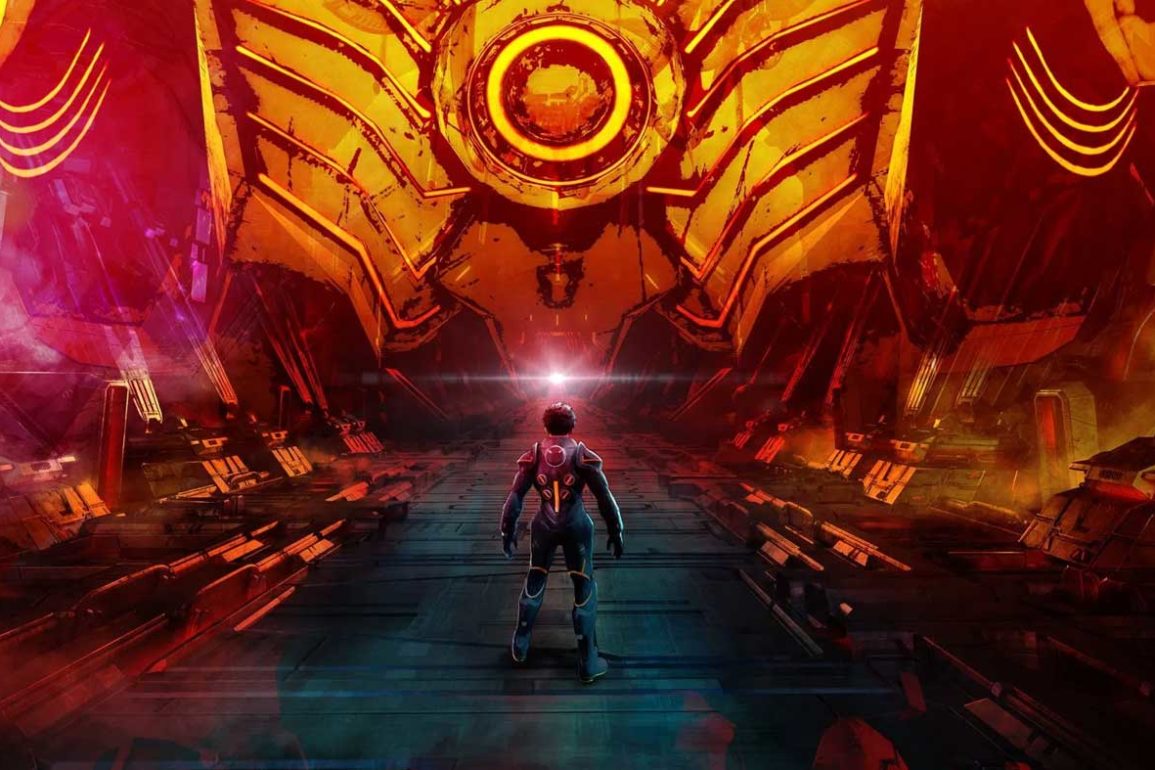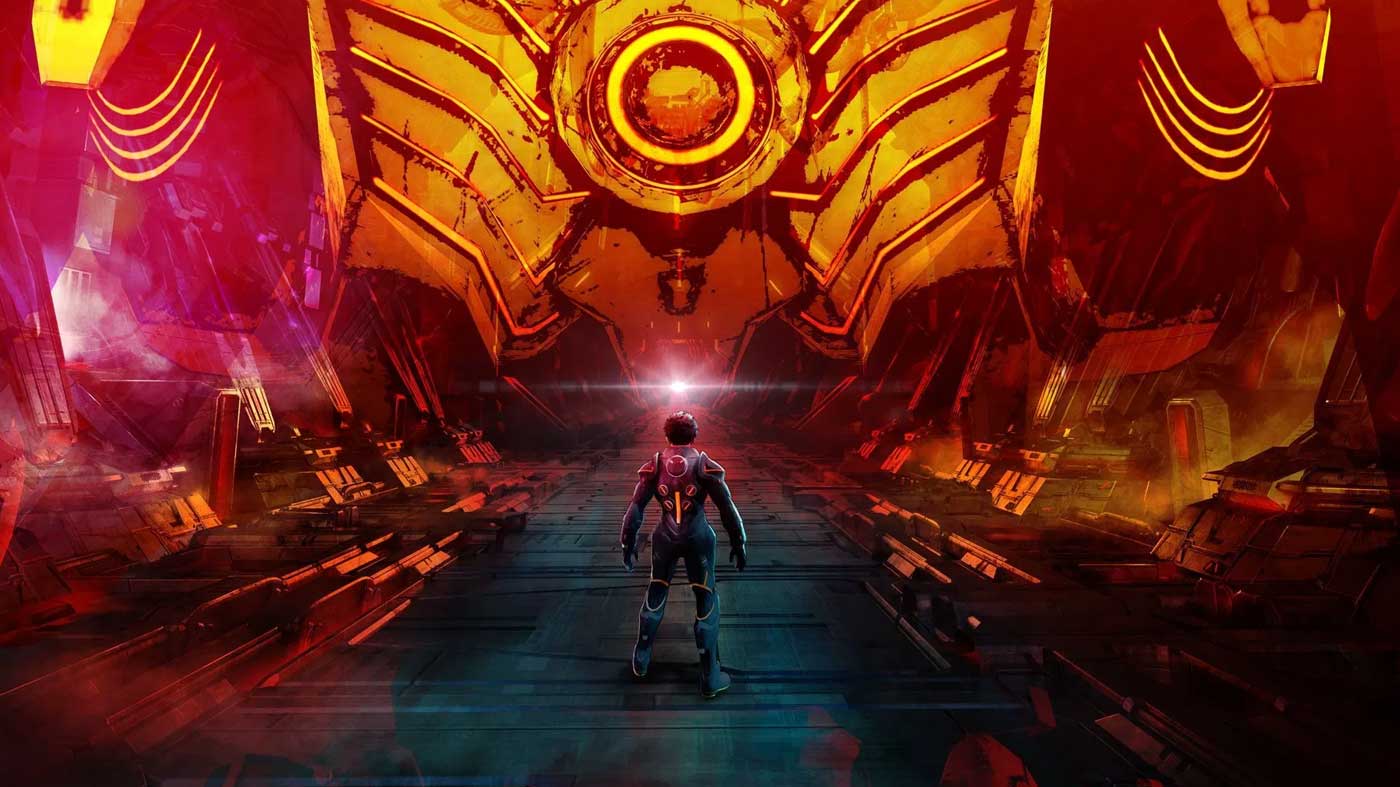Games about mechs are some of my favourites, but unfortunately not really a niche that’s visited too much. Armored Core and to a lesser extent, Chromehounds were games that I loved growing up but not ones without their faults. I’d argue that most mech games in this vein have problems with providing a full and well-rounded package. Daemon X Machina, which is coincidentally produced by a handful of Armored Core alumni, falls into the same traps of its predecessors. But it tries its hardest to differentiate itself in the process which is to be commended.
There’s no debating it, Daemon X Machina tells a trope-laden anime-style story filled with pseudo drama. You play as the Rookie, a pilot of sorts who is naturally gifted at piloting mechs called Arsenals. You join a group of mercenaries to hunt down immortals, giant boss types enemies who walk the world, which has suffered from collapse following a collision with the moon. It’s a great little world that’s set up well in the opening moments of the game, but it quickly becomes clear that it’s all build-up with no pay-off especially with twists that are predictable.

Daemon X Machina is at its core as a mech combat game, not unlike titles such as Zone of the Enders or Armored Core. The general gameplay loop sees you fitting out your mech and heading out on missions. Each mission has a distinct objective, and it’s here where you’ll earn most of the money and components, you’ll need to upgrade your arsenal. Between missions, you’ll listen to inane dialogue that’ll further flesh out the story between characters and factions, but otherwise, Daemon X Machine keeps things simple.
On one hand, this feels like the perfect type of game for the Switch, with missions that rarely last more than five minutes that can be picked up and played with little fanfare. On the other, it does mean that Daemon X Machina feels rather barebones at times – like a portable only spin-off of a better franchise you’ve played elsewhere. It’s almost ironic because the inclusion of the storyline, which I assume is meant to make things feel more fleshed out, detracts from the whole experience and if anything cheapens it.

Thankfully despite these smaller issues, the gameplay in Daemon X Machina is vastly improved since the last few public demos. The Arsenal itself feels weighty yet controls smoothly enough to enable fast and frenetic battling, while your pilot (or Outer, as the game calls them) plays great too. There was never really a point where I felt a failed dodge was anyone’s fault but my own, which is always a good feeling in an action game like this. The controls, in terms of fluidity and responsiveness, just feel right.
There were times, however, where it felt like just a little bit too much was going on, whether it be controlling your Arsenal or activating a specific attack mode or even just pressing a combination of buttons to do so. Some streamlining of the controls has occurred since the demo, but it still feels needlessly complicated and, if you’re not particularly dextrous, a little tough to play proficiently. Bizarrely, despite the lowered health and loss of functionality, I enjoyed playing as my Outer more than my Arsenal in some missions.

It doesn’t help that the game’s many systems and busy user interface aren’t explained to more novice players from the get-go and instead hidden behind optional menus and tutorials, which seems like a bizarre design choice. I suppose the developer’s assumed everyone played the previously released demo builds, but I’m not convinced everybody did.
The combat, while intricate, does feel a little bit simplistic at times, lacking dynamicity. There were so many times where I just remained stationary, firing at enemies until a health bar drained, totally immobile. I don’t mind simplicity in games, but the game gives you so many tools without a dynamic spread of unique situations to properly utilise them. It’s a huge shame because the system behind the combat – the customisation and the weapons available – are so numerous and so well developed.

And when I say numerous, I mean it. Daemon X Machina gives players hundreds of pieces with which to customise their Arsenal. Weapons, armour plates, and decals are all provided in droves in a bid to really help to make your Arsenal your own. While some aspects of your Arsenal can be customised for cosmetic value, others will provide stat boosts or completely change your weapons. Machine guns, rocket launchers, flame throwers, acid spitters, and even arc lightning rifles – there’s a piece of weaponry for every player in Daemon X Machina.
But it can be disappointing that the game never feels challenging enough to require you to actively switch between them. Pretty much any approach mixed with some astute dodging will do. The only exception to this is when you’re facing another Arsenal, in which it honestly feels like there’s no single weapon type that does a good job. It’s frustrating because just when the battles in Daemon X Machina begin to build a strong pace, it all comes to a jarring halt when you come up against another Arsenal whom you have no weapons quick enough to be truly viable.

There are some multiplayer modes available, though this is restricted to separate missions designed specifically for it. It’d a tad disappointing to not be able to play through with your friends – and even more so to have no option to play against them – but it works very well in the few launch day matches I’ve played since the game was released to the public. Given the fast nature of the combat, a PvP mode would’ve been great, but for now, it’s just co-op.
While there is a little bit of variety from the get-go in Daemon X Machina, it quickly becomes rather repetitive. A dry run of the story mode, called “Offer Missions”, can easily be finished in about twelve to fifteen hours depending on how well you roll your equipment – though the game shows you everything it has to offer within four. Those who enjoy games like Monster Hunter will appreciate the grind here, where the general gameplay loop is oddly similar, but the lack of total variety in the package is a bit numbing. It doesn’t help that the story of Daemon X Machina fails to really provide meaningful context to any of these repetitious missions.

Thankfully, the presentation is top-notch. Employing stark and bold bright colours to bring character to its world, Daemon X Machina is one of the nicest looking games on the Switch, even if the performance does falter at times. Expect to do battle with mechs across bright yellow-orange sunsets, or on alien cyan-lime rocky plains. It does look a bit garish at first, but it’s a unique and visually striking art style that really sets apart Daemon X Machina from the rest. I’d recommend playing the game docked – on handheld things can get blurry and shimmery.
The soundtrack is great, with a strong base of heavy metal and rock flavoured beats tinged only with the most subtle of electronica to match the futuristic vibes the game is going for. While the score is great, it does tend to fade into the background of most battles – especially when the game’s colourful cast of characters are attempting to engage you in conversation in combat. Still, when you can hear the soundtrack, it sets the mood superbly.






